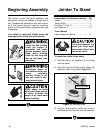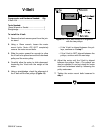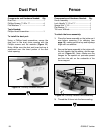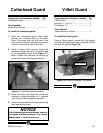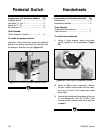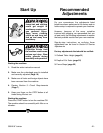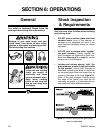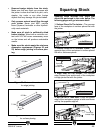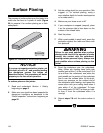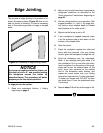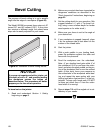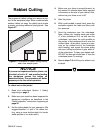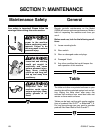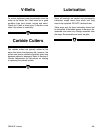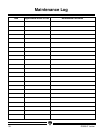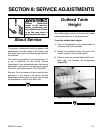
-24-
G0526 6" Jointer
The purpose of surface planing on the jointer is to
make one flat face on a piece of stock (Figure
24) to prepare it for surface planing on a thick-
ness planer.
To surface plane on the jointer:
1. Read and understand Section 1: Safety,
beginning on page 3.
2. Make sure your stock has been inspected for
dangerous conditions as described in the
“Stock Inspection” instructions, beginning on
page 22.
3. Set the cutting depth for your operation. (We
suggest
1
⁄32" for surface planing, using a
more shallow depth for harder wood species
or for wider stock.)
4. Make sure your fence is set to 90˚
5. If your workpiece is cupped (warped), place
it so the concave side is face down on the
surface of the infeed table.
6. Start the jointer.
7. With a push paddle in each hand, press the
workpiece against the table and fence with
firm pressure.
8. Feed the workpiece over the cutterhead.
Note—When your leading hand (with push
paddle) gets within 4" of the cutterhead, lift it
up and over the cutterhead, and place the
push paddle on the portion of the workpiece
that is over the outfeed table. At this point,
focus your pressure on the outfeed end of
the workpiece while feeding, and repeat the
same action with your trailing hand when it
gets within 4" of the cutterhead. To keep
your hands safe, DO NOT let them get clos-
er than 4" from the cutterhead when it is
moving!
9. Repeat steps 7-8 until the entire surface is
flat.
NOTICE
If you are not experienced with a jointer, set
the depth of cut to 0", and practice feeding
the workpiece across the tables as
described below. This procedure will better
prepare you for the actual operation.
Figure 24. Illustration of surface planing results.
Surface Planing
Failure to use push paddles when surface
planing could result in the operator’s hands
coming into contact with the cutterhead,
causing serious personal injury. Always use
push paddles when surface planing on the
jointer.



